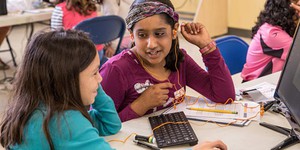Video: Global Problem Solvers: 2.2
Log In
Want to learn more? Check out these other resources:
Lesson Plan
Grade: 4th-8th
Would it be possible to power everything in your classroom using clean, renewable solar power? Inspired by
Global Problem Solvers: The Series,
in this lesson plan, your students will research and design a solar power system for a mobile classroom that can be used after natural disasters or in remote areas without permanent schools.
This lesson is one of three independent lesson plans inspired by Global Problem Solvers: The Series. You can read more about the series and the lesson plans…
Read more
NGSS Performance Expectations:
- 3-5-ETS1-1. Define a simple design problem reflecting a need or a want that includes specified criteria for success and constraints on materials, time, or cost.
- MS-ETS1-1. Define the criteria and constraints of a design problem with sufficient precision to ensure a successful solution, taking into account relevant scientific principles and potential impacts on people and the natural environment that may limit possible solutions.
Lesson Plan
Grade: 4th-8th
How can technology and the internet help us solve some of the world's most pressing problems? Your students might not be ready to tackle global poverty or world peace, but they can start small by identifying a social problem in their local community. In this lesson plan they will design a solution to a problem of their choice that uses technology. It could be anything from a GPS-enabled dog collar to track lost pets, to an app that notifies local food banks when people have extra fruits and…
Read more
NGSS Performance Expectations:
- 3-5-ETS1-1. Define a simple design problem reflecting a need or a want that includes specified criteria for success and constraints on materials, time, or cost.
- 3-5-ETS1-2. Generate and compare multiple possible solutions to a problem based on how well each is likely to meet the criteria and constraints of the problem.
- MS-ETS1-1. Define the criteria and constraints of a design problem with sufficient precision to ensure a successful solution, taking into account relevant scientific principles and potential impacts on people and the natural environment that may limit possible solutions.
- MS-ETS1-2. Evaluate competing design solutions using a systematic process to determine how well they meet the criteria and constraints of the problem.
Blog Post
Watch Global Problem Solvers: The Series with students and talk about the value of STEM problem solving, the engineering design process, teamwork, and social entrepreneurship.
Global Problem Solvers: The Series is an animated video series from Cisco's Corporate Social Responsibility team. Free and available for online viewing in a browser, GPS: The Series offers two seasons (14 mini-episodes) of exciting STEM-powered content for students.
Featuring a…
Read more
Explore Our Science Videos
Making False-Color X-ray Images with NASA Files from the Chandra Observatory
Build an Infinity Mirror | Science Project
Line-Tracking Robot: BlueBot Project #3









